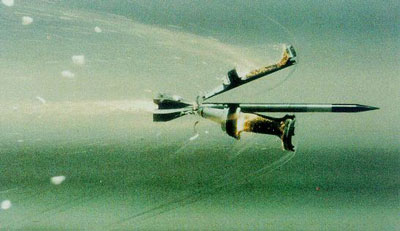
Logo from Scott Cunningham.

Logo from Scott Cunningham.
![]() he first post-war improvement was to add a tungsten alloy cap to the penetrator, first used in the 105mm APDS L28 projectile (and its USA counterpart the M392) developed in Britain in the mid-1950s. Tungsten alloy is more ductile than tungsten carbide and it reduced the tendency of the penetrators to shatter, improving their penetration at oblique angles. In the early 1960s its performance was improved still further with the British development of the 105mm APDS L52 projectile (produced in the USA from 1974 to 1977 as the M728 projectile) which had a penetrator as well as a cap made from tungsten alloy.7
he first post-war improvement was to add a tungsten alloy cap to the penetrator, first used in the 105mm APDS L28 projectile (and its USA counterpart the M392) developed in Britain in the mid-1950s. Tungsten alloy is more ductile than tungsten carbide and it reduced the tendency of the penetrators to shatter, improving their penetration at oblique angles. In the early 1960s its performance was improved still further with the British development of the 105mm APDS L52 projectile (produced in the USA from 1974 to 1977 as the M728 projectile) which had a penetrator as well as a cap made from tungsten alloy.7
Better designs of the sabot reduced its interference with the penetrator at separation, thus improving accuracy.
Efforts were also made to reduce the mass of the sabot which absorbed a considerable amount of kinetic energy at the expense of the penetrator, although not too much could be done in this area because of the stresses on the sabot during firing. Typically the sabot accounted for 21% to 31% of the mass of the projectile, with the sheath accounting for a further amount, leaving about 50% for the penetrator. The inflight diameter (penetrator plus sheath) is typically 60% of the calibre; the diameter of the penetrator is typically 40%.7
The only way to increase penetration was to increase the penetrator’s length to diameter ratio…
Without changing the material of the penetrator and no reduction in the mass of the sabot, the only way to increase penetration was to concentrate the available kinetic energy onto a smaller area by increasing the length to diameter ratio of the penetrator. However spinning projectiles cannot remain stable with a length to diameter of greater than 5 or 6 to 1; for high density sub-calibre shot the maximum is about 4 to 1. Consequently higher length to diameter ratios, and therefore better penetration, can only be achieved by abandoning spin stabilisation and adopting aerodynamic stabilisation using fins, and so was born the APFSDS projectile.7

A spectacular photograph showing an APFSDS projectile in flight separating from its sabot. The curved lines around the sabot are the shock waves caused by flight at supersonic speeds. The fins at the rear of the penetrator provide aerodynamic stabilisation, required because the length to diameter ratio of the penetrator is too high for spin stabilisation. From the Military Analysis Network.
The advantage of APFSDS projectiles is a significantly greater armour penetration, far better than any other type of sub-calibre projectile. This advantage is increased still further by the use of depleted uranium for the penetrator from the late 1970s, which has an even higher density than tungsten carbide (18.6g/cc compared to 14.3–16.3g/cc). Uranium is pyrophoric, meaning that during penetration particles of the penetrator will ignite, adding to its destructive capability. Objections to the use of depleted uranium have been raised because of its radioactivity which is actually quite low; its toxicity should probably be of greater concern.7
APFSDS has few disadvantages. Early Soviet style APFSDS, with their enormous bore-riding fins, bulky bodies, and lightweight steel construction, had higher drag than a typically smooth spin stabilised APDS projectile, so velocity and therefore penetration fell off slightly more with range. This is not the case for other APFSDS projectiles; the velocity drop with range is less than that for a contemporary APDS projectiles.11 While some sources claim better accuracy for spin stabilised projectiles over fin stabilised,7 comparison of individual round accuracy from about the mid 1970s onwards shows that APFSDS is at least the equal of, and in many cases better than, spin stabilised APDS.11
Development of APFSDS projectiles began in earnest in the Soviet Union and the USA in the 1950s. Since the 1980s it has become the primary anti-tank ammunition for main battle tanks.
 Shaped Charge Ammunition Part 1 General Design
Shaped Charge Ammunition Part 1 General Design
Do you like this web site? Please rate it between one and ten, with ten being the best:
Ratings are submitted to: The Wargames and Military History Search Engine.
Copyright © 2000 David Michael Honner. E-mail: GvA@wargamer.org.